Marrying Vega and Zen: The AMD Ryzen 5 2400G Review
by Ian Cutress on February 12, 2018 9:00 AM ESTBenchmarking Performance: CPU Encoding Tests
One of the interesting elements on modern processors is encoding performance. This includes encryption/decryption, as well as video transcoding from one video format to another. In the encrypt/decrypt scenario, this remains pertinent to on-the-fly encryption of sensitive data - a process by which more modern devices are leaning to for software security. Video transcoding as a tool to adjust the quality, file size and resolution of a video file has boomed in recent years, such as providing the optimum video for devices before consumption, or for game streamers who are wanting to upload the output from their video camera in real-time. As we move into live 3D video, this task will only get more strenuous, and it turns out that the performance of certain algorithms is a function of the input/output of the content.
All of our benchmark results can also be found in our benchmark engine, Bench.
7-Zip 9.2: link
One of the freeware compression tools that offers good scaling performance between processors is 7-Zip. It runs under an open-source licence, is fast, and easy to use tool for power users. We run the benchmark mode via the command line for four loops and take the output score.
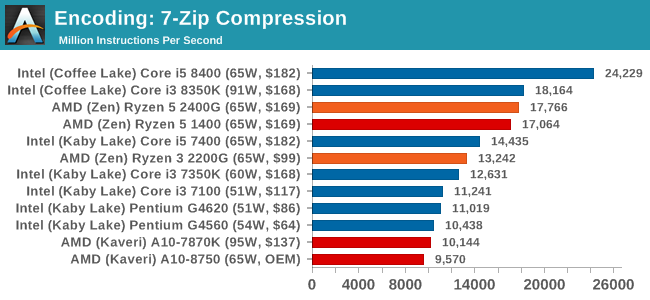
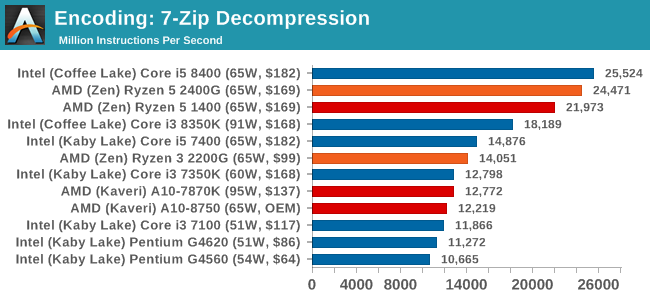
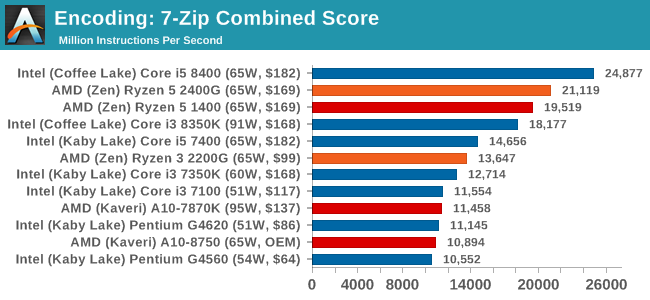
7-zip gives two contrasting stories here. For compression, full cores are needed to get the best performance, with frequency helping as well. However, for decompression, the extra threads help a lot. The combined result looks more like the decompression score, with the Ryzen 5 2400G sitting between the six-core Core i5-8400 and the quad-core Core i3-8350K.
WinRAR 5.40: link
For the 2017 test suite, we move to the latest version of WinRAR in our compression test. WinRAR in some quarters is more user friendly that 7-Zip, hence its inclusion. Rather than use a benchmark mode as we did with 7-Zip, here we take a set of files representative of a generic stack (33 video files in 1.37 GB, 2834 smaller website files in 370 folders in 150 MB) of compressible and incompressible formats. The results shown are the time taken to encode the file. Due to DRAM caching, we run the test 10 times and take the average of the last five runs when the benchmark is in a steady state.
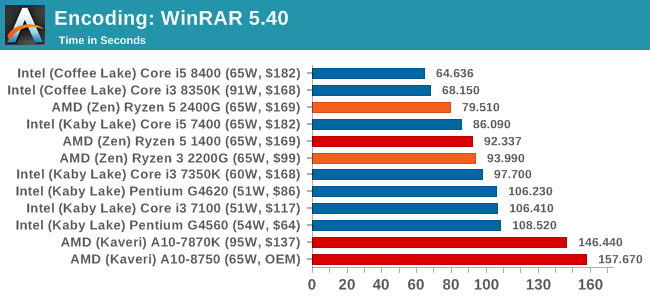
WinRAR is a good scaler with cores, frequency, and memory performance. The eight threads and DDR4-2933 contributes a good amount to the performance here, especially in light of where AMD was. The jump from the Ryzen 5 1400 to the 2400G is also noticable, due to the uptick in frequency and memory speed. The high single-thread performance of the Intel cores still wins out, however.
AES Encoding
Algorithms using AES coding have spread far and wide as a ubiquitous tool for encryption. Again, this is another CPU limited test, and modern CPUs have special AES pathways to accelerate their performance. We often see scaling in both frequency and cores with this benchmark. We use the latest version of TrueCrypt and run its benchmark mode over 1GB of in-DRAM data. Results shown are the GB/s average of encryption and decryption.
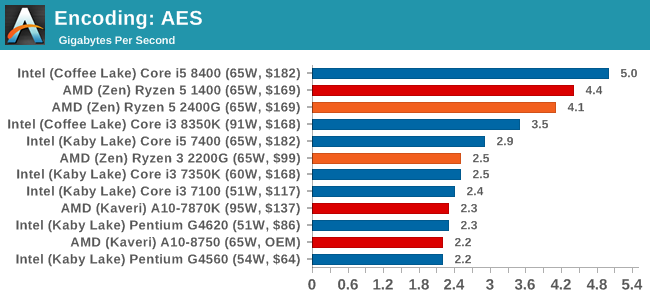
HandBrake v1.0.2 H264 and HEVC: link
As mentioned above, video transcoding (both encode and decode) is a hot topic in performance metrics as more and more content is being created. First consideration is the standard in which the video is encoded, which can be lossless or lossy, trade performance for file-size, trade quality for file-size, or all of the above can increase encoding rates to help accelerate decoding rates. Alongside Google's favorite codec, VP9, there are two others that are taking hold: H264, the older codec, is practically everywhere and is designed to be optimized for 1080p video, and HEVC (or H265) that is aimed to provide the same quality as H264 but at a lower file-size (or better quality for the same size). HEVC is important as 4K is streamed over the air, meaning less bits need to be transferred for the same quality content.
Handbrake is a favored tool for transcoding, and so our test regime takes care of three areas.
Low Quality/Resolution H264: Here we transcode a 640x266 H264 rip of a 2 hour film, and change the encoding from Main profile to High profile, using the very-fast preset.
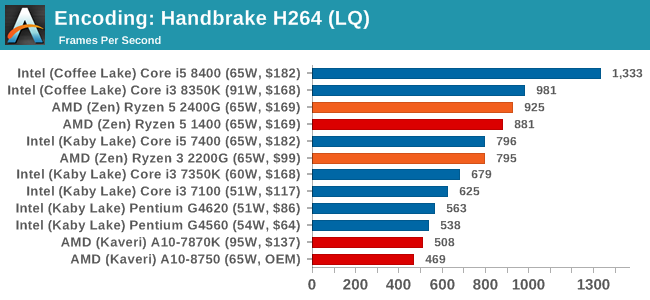
High Quality/Resolution H264: A similar test, but this time we take a ten-minute double 4K (3840x4320) file running at 60 Hz and transcode from Main to High, using the very-fast preset.
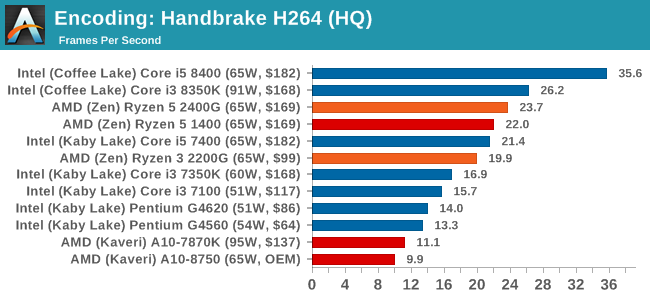
HEVC Test: Using the same video in HQ, we change the resolution and codec of the original video from 4K60 in H264 into 4K60 HEVC.
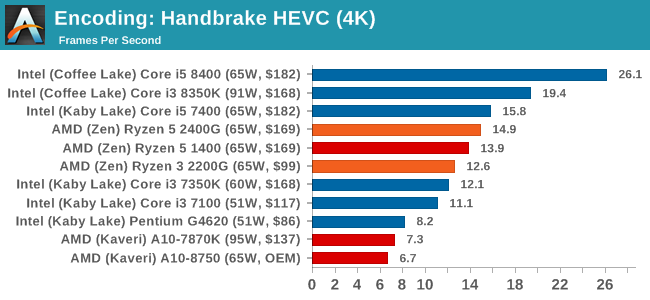










177 Comments
View All Comments
HStewart - Monday, February 12, 2018 - link
I don't get the idea of desktops except if you want ultimate gaming PC - go with High End CPU a long with High End GPU. Otherwise go mobile. You can pretty much go that route unless you desired extreme top end performanceIf you primary into game get a Xbox One X or S and HDTV are cheap or PS 4,
But lower end desktop PC - I see no need them for now. Times have changed
Lolimaster - Monday, February 12, 2018 - link
If you wanna upgrade a laptop, be prepared for a bunch of cabling.Have 3-4 drives on mobile?
Dedicated capture/sound card?
Keep your thermals in check?
Upgrade your cpu/apu whenever you like?
mikato - Saturday, February 17, 2018 - link
To me laptops are annoying, and only convenient for basic tasks with their mobility. Otherwise they are slow, have a small screen, often don’t a have mouse, and no number pad on keyboard. As a result, typing is slower, pointing is slower, app speed is slower, and gaming performance is worse. With the smaller screen, juggling things, dragging files, etc is more difficult. I just can’t get stuff done as well on a laptop as a desktop.oldschool_75 - Monday, February 12, 2018 - link
Why do the Intel systems have 32 gigs of ram while the AMD systems only have 16?Also bulldozer was not 2 cores 4 threads, it was two modules with two cores sharing the modules so 4 cores.
Lolimaster - Monday, February 12, 2018 - link
Why use 2933 memory?As far as i know AMD send 3200 CL14 Flare X to pretty much everyone for the sake of testing the gpu at 3200 CL14 !!!!
jjj - Monday, February 12, 2018 - link
They use the frequencies officially supported , anything above that is OC and would fall into the OC section. It's debatable how right or wrong that is but that's what AT does.Lolimaster - Monday, February 12, 2018 - link
Guru3d got the reviewer's kit with 3200 cl14 flare-x as 100% of the techtoubers too.ScottSoapbox - Monday, February 12, 2018 - link
The number of typos in the first two sentences was enough for me to stop reading.Lolimaster - Monday, February 12, 2018 - link
The avrg l3 latency for non-APU multiple CCX Ryzen's was around 11-12ns, on the single CCX APU is aroun 9.5ns.Memory latency Ryzen
91ns DDR4 2400
77ns DDR4 3200
2400G
66ns DDR4 3200
Macpoedel - Monday, February 12, 2018 - link
Good to see you started testing CPU's with maximum supported RAM speed instead of JEDEC frequency. These APU's would have really suffered if tested with 2133MHz DDR4 RAM.